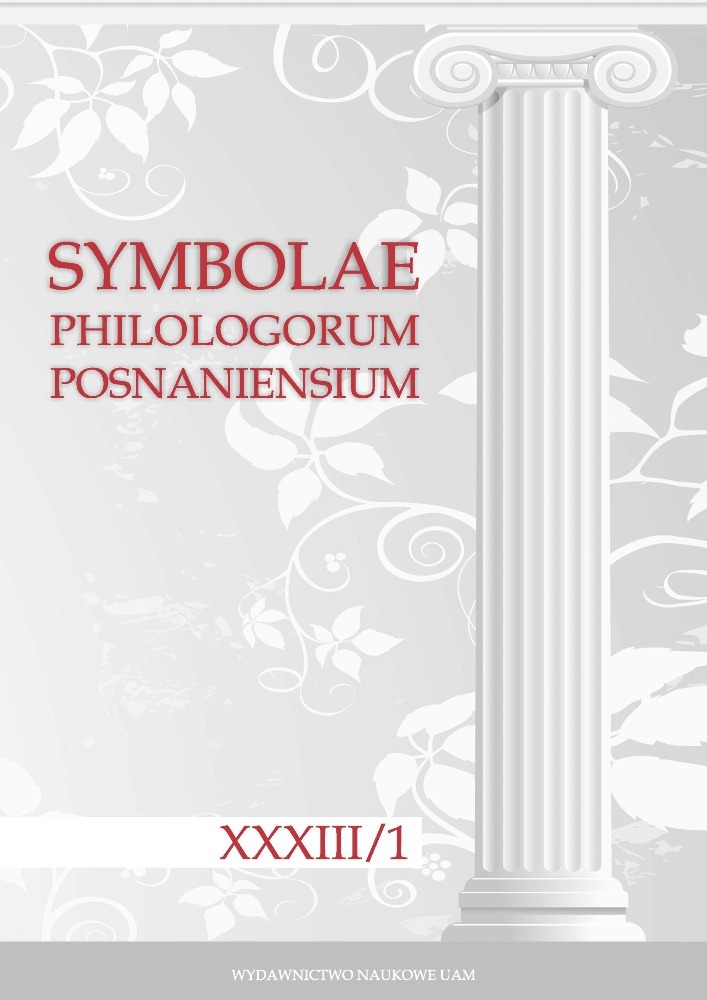Abstract
The article presents a critical discussion of the interpretation of one of Balbilla’s epigrams carved on the foot of Memnon’s colossus at Egyptian Thebes (Bernand no. 31) proposed by Marialuigia Di Marzio in her article published in QUCC 2019. According to this interpretation, it contained the acrostic ΕΦΗΩΚΑΕ, which Di Marzio resolves as ΕΦΗ Ω ΚΑΕ(ΣΑΡ), suggesting a direct apostrophe to the emperor Hadrian on the part of the statue. However, there are compelling reasons to reject this intriguing proposal.
Literaturhinweise
Bernand 1960: A. Bernand, É. Bernand. Les inscriptions grecques et latines du Colosse de Memnon. 1960. Paris.
Cirio 2011: A. M. Cirio. Gli epigrammi di Giulia Balbilla. 1960. Lecce.
Danielewicz 2013: Danielewicz, J. 2013. “An Unnoticed Second Acrostic in the Kalabsha Inscription of Paccius Maximus (IMEG 168).” In The Muse at Play: Riddles and Wordplay in Greek and Latin Poetry. Ed. by J. Kwapisz, D. Petrain, M. Szymański, 326–330. Berlin-Boston: Walter de Gruyter.
Di Marzio 2019: Di Marzio, M. 2019. “L’Epigramma 31 Bernand di Giulia Balbilla e l’acrostico con la voce di Phamenoth/Memnone”. Quaderni Urbinati di Cultura Classica, n.s. 123/3: 105–130.
Di Marzio 2020: Di Marzio, M. 2020. “Le ‘immagini orarie’ negli Epigrammi 28–31Bernand di Giulia Balbilla: ipotesi per una nuova interpretazione.” Rivista di cultura classica e medioevale 72/1: 51–69.
Garulli 2013: Garulli, V. 2013. “Greek Acrostic Verse Inscriptions.” In The Muse at Play: Riddles and Wordplay in Greek and Latin Poetry. Ed. by J. Kwapisz, D. Petrain, M. Szymański, 246–278. Berlin-Boston: Walter de Gruyter. DOI: https://doi.org/10.1515/9783110270617.246
Hartmann, MacDonald 1969: Hartmann, J.E., MacDonald, G. 1969. Greek Numismatic Epigraphy. Chicago.
McLean 2002: McLean, B.H. 2002. An Introduction to Greek Epigraphy of the Hellenistic and Roman Periods from Alexander the Great down to the Reign of Constantine (323 B.C. – A.D. 337). University of Michigan Press. DOI: https://doi.org/10.3998/mpub.23012
Moreno 2015: Moreno, J.G. 2015. “La voz del coloso de Memnón: estudio lingüístico de los términos que la describen.” Ianua Classicorum. Temas y formas del Mundo Clásico 1, 2015: 513–522.
Rosenmeyer 2008: Rosenmeyer, P.A. 2008. “Greek Verse Inscriptions in Roman Egypt: Julia Balbilla’s Sapphic Voice.” Classical Antiquity 27/2, 2008: 334–58. DOI: https://doi.org/10.1525/ca.2008.27.2.334
Rosenmeyer 2018: Rosenmeyer, P.A. 2018. The Language of Ruins. Greek and Latin Inscriptions on the Memnon Colossus. Oxford: Oxford University Press. DOI: https://doi.org/10.1093/oso/9780190626310.001.0001
Rosenmeyer 2019: Rosenmeyer, P.A. 2019. “Encrypted Inscriptions”. In From Document to History: Epigraphic Insights into the Greco-Roman World. Ed. by C. F. Noreña, N. Papazarkadas, 373–392. Leiden–Boston: Brill. DOI: https://doi.org/10.1163/9789004382886_022
https://www.forumancientcoins.com/dougsmith/abb.html (Abbreviations on Roman Imperial Coins)


